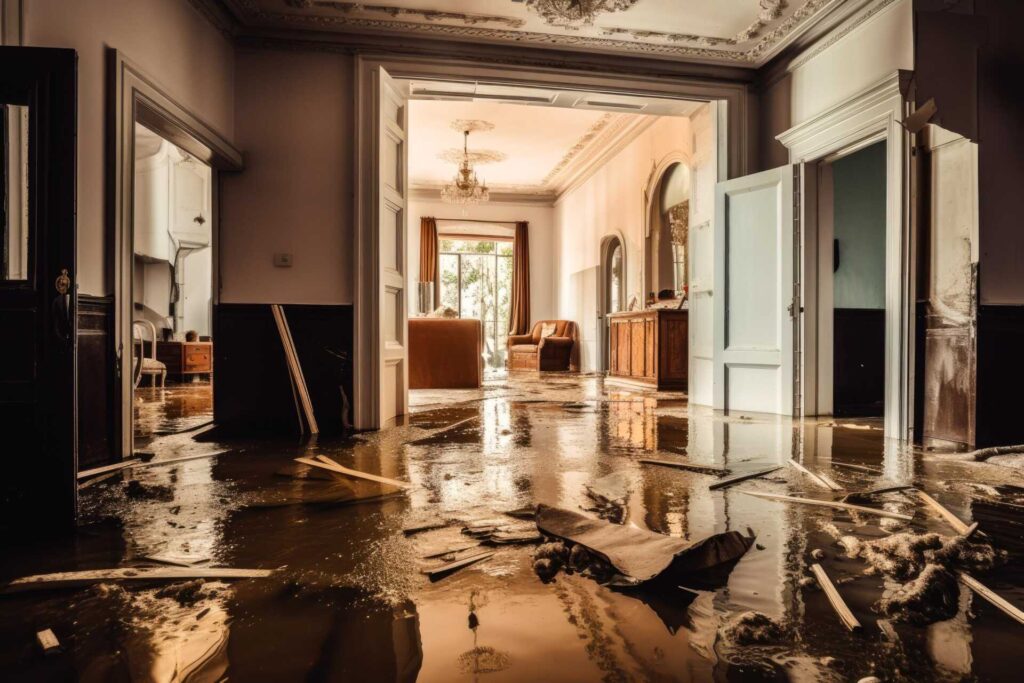
Contents
After experiencing water damage, you need to act quickly to prevent mold growth. Mold can develop in just 24 to 48 hours if conditions are right. By removing standing water and ensuring proper ventilation, you can greatly reduce the risk. However, it doesn’t stop there. Understanding how to maintain low moisture levels and clean effectively is vital. Let’s explore the essential steps you should take to protect your home from mold hazards.
Key Takeaways
- Act quickly to remove standing water to prevent mold growth within 24 to 48 hours.
- Ensure proper ventilation in affected areas by opening windows and using fans for airflow.
- Use dehumidifiers to maintain indoor humidity levels between 30% and 60%.
- Clean and disinfect surfaces thoroughly with water, detergent, and EPA-approved disinfectants.
- Regularly monitor for signs of mold growth in moisture-prone areas and address issues immediately.
Act Quickly to Remove Standing Water
Act quickly to eliminate standing water, as it creates an ideal environment for mold growth. When water accumulates, it increases humidity and provides a perfect breeding ground for mold spores.
You should inspect your property immediately after any water intrusion, whether from flooding, leaks, or spills. If you find standing water, use pumps or wet vacuums to remove it promptly.
Ensure you wear protective gear and follow safety protocols while handling water-damaged areas.
Once the water is gone, thoroughly dry the affected surfaces within 24 to 48 hours to prevent mold development. Utilize fans and dehumidifiers to expedite the drying process.
Check hidden spaces like behind appliances or within walls, as water can often linger unnoticed.
Ensure Proper Ventilation in Affected Areas
To prevent mold growth effectively, ensuring proper ventilation in affected areas is essential, especially after water damage has occurred.
Mold thrives in damp, stagnant environments, making airflow critical for drying out spaces. Open windows and doors whenever possible to facilitate fresh air circulation. If it’s safe, use fans to increase airflow, directing them towards wet surfaces to promote evaporation.
Consider creating cross-ventilation by opening multiple windows or using exhaust fans in nearby areas.
If you’re dealing with enclosed spaces, like basements or closets, keep doors ajar to encourage airflow. Additionally, check that vents and ducts are unobstructed to allow air to flow freely.
Use Dehumidifiers to Reduce Moisture Levels
Since high humidity levels can greatly contribute to mold growth, using dehumidifiers is a practical solution for reducing moisture in your home.
These devices work by extracting excess water vapor from the air, effectively lowering humidity levels and creating an environment less conducive to mold. It’s important to choose a dehumidifier with the appropriate capacity for your space; smaller units may struggle in larger areas, while oversized models can lead to excessive dryness.
Set your dehumidifier to maintain indoor humidity between 30% and 60%. Regularly empty the water reservoir or opt for a continuous drainage option to ensure peak performance.
Keep windows and doors closed while the dehumidifier is running to maximize its efficiency. Remember to clean the unit’s filter and coils periodically to maintain airflow and functionality.
Clean and Disinfect Surfaces Thoroughly
While maintaining a clean environment is crucial for mold prevention, it’s important to focus on cleaning and disinfecting surfaces thoroughly.
After water damage, surfaces can harbor mold spores, making immediate action necessary. Here are key steps to ensure effective cleaning:
Use a detergent: Clean surfaces with a mixture of water and detergent to remove dirt and debris.
Apply a disinfectant: Use EPA-approved products to kill mold spores and bacteria on non-porous surfaces.
Scrub thoroughly: Pay special attention to corners and crevices where moisture may linger.
Rinse and dry: After disinfecting, rinse surfaces with clean water and dry them completely to prevent moisture accumulation.
Wear protective gear: Always use gloves, masks, and goggles to protect yourself from harmful substances.
Monitor for Signs of Mold Growth Regularly
After cleaning and disinfecting surfaces, staying vigilant for signs of mold growth is essential to maintaining a healthy environment. Regularly inspect areas prone to moisture, like bathrooms, kitchens, and basements. Look for discoloration, musty odors, or visible mold patches, which can indicate larger issues.
Use a flashlight to examine hidden corners and behind furniture where mold might thrive undetected.
Keep an eye on humidity levels; ideally, they should stay between 30% and 60%. Consider using a hygrometer to track this. If you notice condensation on windows or walls, it’s a sign of excess moisture that could foster mold growth.
Prompt action is vital; if you spot mold, address it immediately by cleaning or seeking professional help. By monitoring regularly, you’ll create a safer, healthier home environment for yourself and your loved ones.
Wrap-Up
By following these five essential tips, you can gracefully sidestep the lurking shadows of mold that often accompany water damage. Acting swiftly to remove standing water, ensuring proper ventilation, utilizing dehumidifiers, thoroughly cleaning surfaces, and keeping a watchful eye for any signs of mold will help maintain a healthy environment in your home. Embrace these proactive measures, and you’ll safeguard your space from unwelcome guests of moisture-related issues, allowing you to breathe easy once more.
Recent Posts
Why Quick Water Extraction Matters for Mold Prevention?
Imagine a damp, dark corner of your home where mold spores quietly wait for the
Top Tips for Mold-Free Water Extraction
Imagine a homeowner who discovers water pooling in their basement after a heavy rainstorm. They
Essential Tips for Emergency Water Extraction
You might think water extraction is a straightforward task, but it’s vital to approach it
